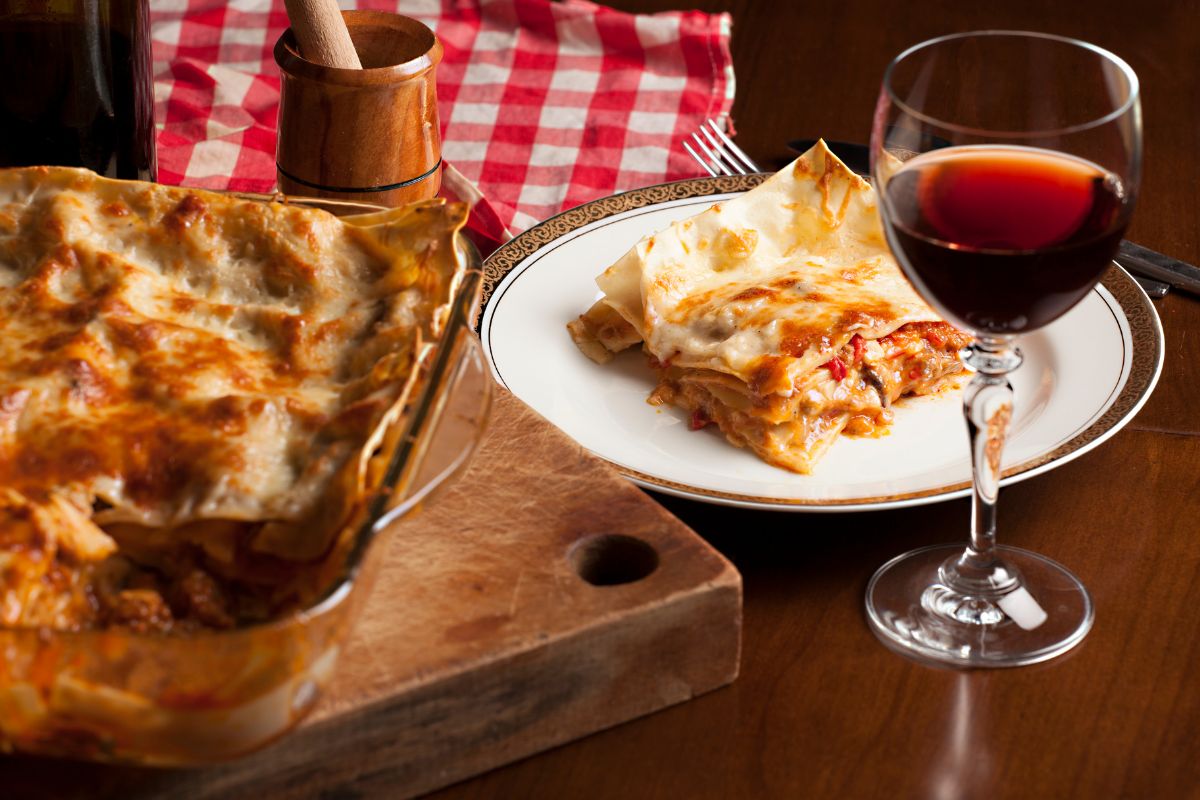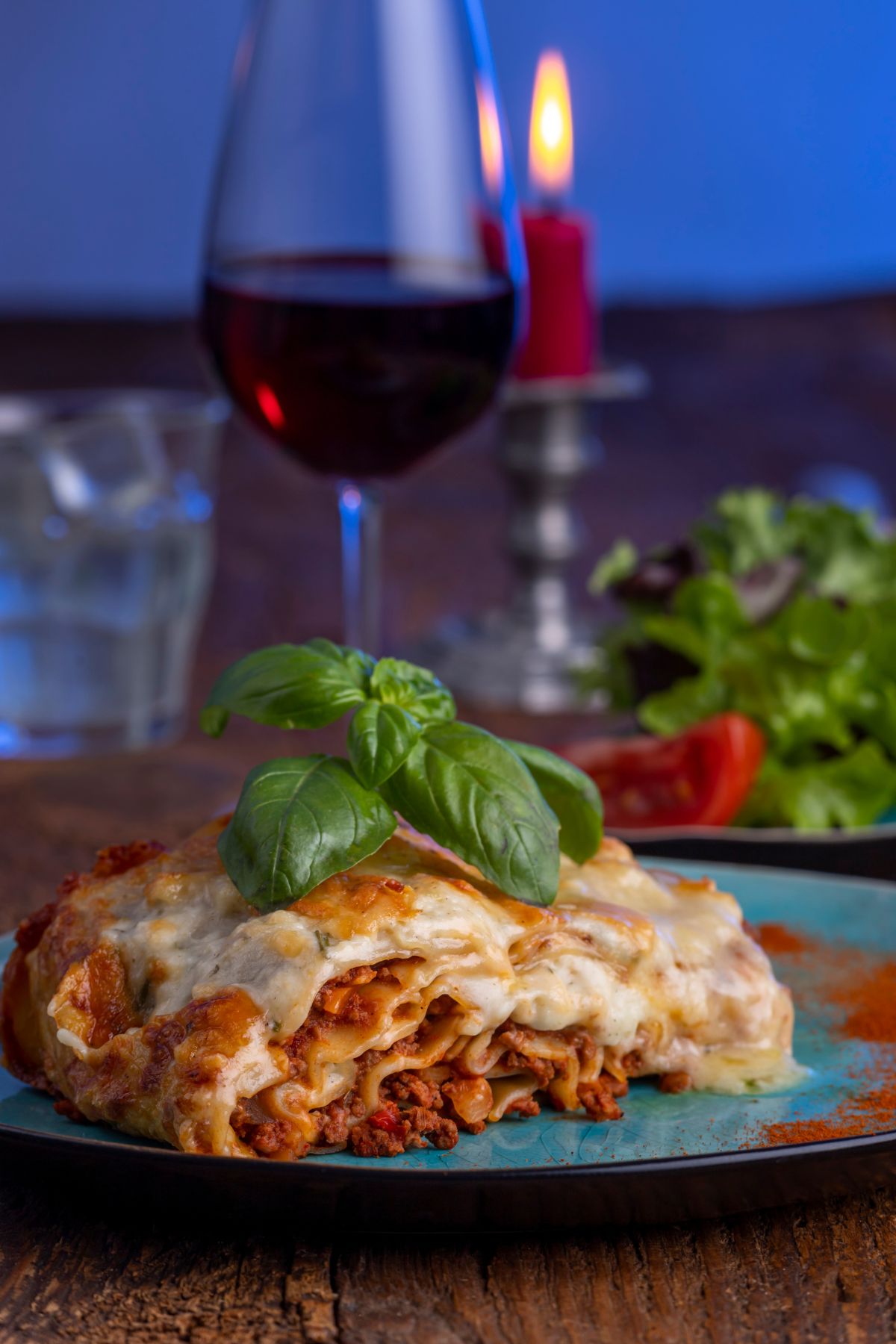What Wine Goes Best With Lasagna?
Many people love to have their best wine with lasagna. Although there are numerous varieties nowadays, meat-based lasagna typically comes to mind when we think about combining wine with lasagna.
So, just as with pasta sauces, the wine you choose for a meal should complement the other ingredients. So what is the best wine to pair with lasagna? Read on to find out.
Why to Have Lasagna and Wine
The most well-known Italian red wine with lasagna on the market. Chianti has the flavors of Italy: it’s tart, earthy, herbal, and fruity. Contrasting the rich aromas of lasagna with the vibrant red and black cherry flavors is a great change.
Each bite tastes fresh as the wine’s acidity clears your taste buds in the meantime. Because the first two or three bites of lasagna are so good, it’s pretty simple to overindulge in it. Your taste buds, on the other hand, become clogged with sugar and flavor fat in the absence of an acidic liquid.
Each piece becomes less flavorful, and we frantically stuff more lasagna into our mouths to recreate those first delectable bits. Overindulgence is not a problem when drinking Chianti Classico since the acidity refreshes your palate, making each bite taste just like the first. As a result, you eat less since you feel full faster.

The Best Wines With Lasagna
You can have your best red wine with lasagna whenever you want. For the traditional lasagna, follow our wine suggestions. You can now create the traditional lasagna in various inventive ways, such as with turkey, lamb, pig, pumpkin, eggs, goat cheese, pesto, or vegetarian alternatives.
| Type | Varietal | Food | Rating |
| Red Wine | Chianti Classico | Lasagna | 4.5 out of 5 stars |
| Red Wine | Barbera | Lasagna | 4 out of 5 stars |
| Red Wine | Dolcetto | Lasagna | 4 out of 5 stars |
| Red Wine | Sangiovese | Lasagna | 4 out of 5 stars |
| Red Wine | Nero d’Avola | Lasagna | 4 out of 5 stars |
| Red Wine | Merlot – Medium Bodied | Lasagna | 4 out of 5 stars |
| White Wine | Sauvignon Blanc | Vegetarian Lasagna | 4 out of 5 stars |
Chianti Classico & Lasagna Pairing
The most well-known Italian red wine on the market is Chianti Classico. Chianti has the flavors of Italy: it’s tart, earthy, herbal, and fruity. The flavor of the brilliant red and black cherry provides a wonderful contrast to the rich flavors of the lasagna.
Each bite tastes fresh as the wine’s acidity clears your taste buds in the meantime. Because the first two or three bites of lasagna are so good, it’s straightforward to overindulge in this meal.
However, fat and carbs block up your taste buds if you don’t drink anything acidic. Each bite becomes less flavorful, and we frantically cram more lasagna into our mouths to recreate those first delectable bits.
Overindulgence is not a problem when drinking Chianti Classico since the acidity refreshes your palate, making each bite taste just like the first. As a result, you eat less since you feel full faster.
The minced garlic, onions, mushrooms, meat, bell peppers, and herbs in your lasagna pair perfectly with the earthy, smokey, and herbal qualities of Chianti Classico, which is also fruity.
Chianti Classico has a different meaning than simply “Chianti,” thus, we particularly emphasize that for this match.
What’s the Difference Between Chianti Classico and Chianti?
“Chianti Classico” designates the historic area where Chianti comes from. Chianti is now used to describe everything outside of this initial region as the bounds of Chianti enlarged as the part gained fame.
Sangiovese must make up at least 80% of Chianti Classico, whereas Sangiovese must make up at least 70% of Chianti. Although certain Chianti and Chianti Classico wines may contain only Sangiovese, not all Chiantis are equal. Additionally, it cannot be easy to understand a wine bottle’s label if you are a novice.
As a result, if you’re making a blind purchase, I recommend sticking with Chianti Classico because it’s more likely to have the most Sangiovese. The acidic flavors of Sangiovese substantially change when they add other grapes, such as Cabernet Sauvignon or Merlot, which reduces its appeal when paired with Lasagna.
Chianti Classico is easily recognized, thanks to the black rooster label on the stem of the wine bottle.

Italian Barbera & Lasagna Pairing
The red wine grape variety Barbera is low in tannin and inherently acidic. Although it is grown in British Columbia, Argentina, Australia, and California, it is most famous in Italy; the Piedmont region is where Barbera is from.
You may hear it described as either Barbera d’Alba, which has a larger body, or Barbera d’Asti, which has a lighter body and more acidic flavor (but not by much).
Additionally, you might come across Barbera del Monferrato, a lean, acidic kind of Barbera with flavors of fresh red fruit. Italian Barbera from the three regions mentioned above tastes like black and red cherries and is best when you consume it immediately.
Rustic flavors of herbs, earth, minerals, and spices are also present; however, they are subtle. You won’t detect them unless they have a sensitive palate.
In contrast to the rich and complex flavors of your lasagna, the contrasting fruit flavors of Barbera deliver warmly refreshing flavors. The rustic appeal complements the acidic and aromatic tomato sauce.
It is impossible to predict the taste of barbera from other locations because they might not be like the creations in the traditional Italian manner.
You can also produce Barbera in a way that allows it to mature; however, these bottles are frequently somewhat pricey. Start easy while preparing lasagna by selecting a Barbera d’Alba or Barbera d’Asti that is reasonably priced.
Lasagna and Nero D’Avola
The wine called Nero d’Avola comes from Sicily in Italy. The Nero d’Avola grape, one of Sicily’s most popular red wine grapes, is an ingredient in making the wine.
The wine boasts black cherry, blackberry, plum, and spice flavors, as well as high acidity and moderate tannins.
Nero d’Avola wine complements lasagna well because its acidity helps to cut through the dish’s richness. The wine’s gentle tannins also aid in balancing the flavors of the lasagna.
The difference between Barbera and Nero d’Avola
Barbera is a wine with a light to medium body, high acidity, and moderate tannins. Full-bodied Nero d’Avola wine has strong tannins and slight acidity. Both wines are fruity, although Barbera is tarter and sweeter than Nero d’Avola.
A good wine pairing for lasagna is Barbera since it can withstand the dish’s robust ingredients without overpowering the sauce’s exquisite harmony. Nero d’Avola is another excellent option.
However, some individuals might find its high tannin content too harsh. A Nero d’Avola matured in oak barrels will have softer tannins, so if you want to taste one, check for it.
Sangiovese and Lasagna
One of the best wine to drink with lasagna is Sangiovese. This is because the strength of lasagna pairs well with the acidic and savory Sangiovese wine. The rustic flavor profile and high acidity simultaneously cut through creamy fat and tarantellas with tomato. Sangio is even up for the challenge if you wish to take a non-traditional route.
The top wine in Italy, Sangiovese, is delectable, widely available, and pairs nicely with all types of lasagna. Although we might be discussing two different topics about lasagna, we both might be. Perhaps in your mind, the dish is entirely covered in red sauce and filled with ricotta, sausage, and eggs like Nonna used to do.
Lasagna and Dolcetto
Dolcetto is a light-bodied, very acidic wine from Italy. You can taste almonds and black cherries in it. Due to its high acidity, this wine will effectively cut through the richness of lasagna. The tomato sauce in the lasagna’s tomato sauce will go well with the cherry tastes.
Sauvignon Blanc
Do you know that the prior Cabernet Sauvignon’s “mother” wine is Sauvignon Blanc?
You can detect fruitily (from citrus fruits like lime, grapefruit, and passion fruit with pear, white peach, and tropical produce) and moderately peppery undertones in this dry white wine (from the jalapeno bell pepper, vanilla, nutmeg, and clove).
Additionally, Sauvignon Blanc contributes wonderful acidic, alcoholic, and herbal nuances (lemongrass, cut grass, and tarragon). All the qualities mentioned above make this well-known wine best for meat lasagna wine pairing.
Here’s a quick tip: Sauvignon Blanc pairs particularly nicely with caviar, especially white sturgeon caviar. Sauvignon Blanc’s herby hints elevate the nutty nuances of most caviar varietals.
Merlot
Merlot is produced from the grape grown internationally, second only to Cabernet Sauvignon. These Merlot wines are softer, smoother red wines that are excellent to start with if you are a beginner and made from a specific grape variety with a dark blue/black skin.
Merlot is a fantastic pair for the tomato sauces in lasagna since it has fewer tannins and a deeper, more mellowly, fruity sweetness (from plum and blackberries). This style of wine can complement meaty lasagnas (with full-bodied variations) and dishes with bacon, pancetta, or mushrooms (with lighter-bodied ones).
Here, the main thing to keep in mind is to keep Merlot away from creamy sauces like bechamel. Is there a reason why Merlot is a wine for beginners? The solution is right there!
Does White Wine Go With Lasagna
What wine goes best with lasagna? White wine will pair nicely with lasagna but won’t enhance the savory flavors. You can therefore give contrasting and energizing fruit flavors with white wine. Because it’s popular and simple to find on a wine list by the glass (any Italian restaurant that offers wine should have it), Pinot Grigio pairs well with lasagna.
The light, crisp white wine, also called Italian Pinot Grigio, has hints of peach, pear, apple, and minerals. Pinot Grigio has a strong acidity and tastes dry. No component of your lasagna goes undetected thanks to the acidity, which also brings out the distinct flavors you’ve added.
Lasagna pairs well with rosé and sparkling wines like prosecco. Since lasagna doesn’t call for sweetness, both types of wine should be dry if possible (the tomato sauce is already sweet enough).
While Rosé is frequently tart but dry, helping it to cut through the gooey cheese and bring out the delectable tastes in your Lasagna that you never noticed before, bubbly white wines are acidic, so they help keep your palette cleansed.

Final Thoughts
So there you have it: wine pairing with lasagna options that will tickle your taste senses. We have the ideal wine combination for you, whether you are a wine fan or just seeking to add a little flavor to your lasagna.
However, once you start pairing good wine with lasagna, you might never go back to drinking only water. Cheers!

Community of passionate writers and content creators who share a love for Italian heritage, culture, travel, food, and the Italian-American community. Our mission is to celebrate Italy’s rich history and traditions and connect with others who share the same passion.

